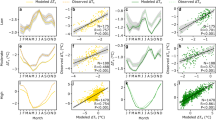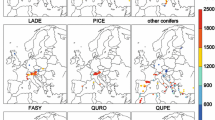Abstract
The projected response of coniferous forests to a climatic change scenario of doubled atmospheric CO2, air temperature of +4 °C, and +10% precipitation was studied using a computer simulation model of forest ecosystem processes. A topographically complex forested region of Montana was simulated to study regional climate change induced forest responses. In general, increases of 10–20% in LAI, and 20–30% in evapotranspiration (ET) and photosynthesis (PSN) were projected. Snowpack duration decreased by 19–69 days depending on location, and growing season length increased proportionally. However, hydrologic outflow, primarily fed by snowmelt in this region, was projected to decrease by as much as 30%, which could virtually dry up rivers and irrigation water in the future.
To understand the simulated forest responses, and explore the extent to which these results might apply continentally, seasonal hydrologic partitioning between outflow and ET, PSN, respiration, and net primary production (NPP) were simulated for two contrasting climates of Jacksonville, Florida (hot, wet) and Missoula, Montana (cold, dry). Three forest responses were studied sequentially from; climate change alone, addition of CO2 induced tree physiological responses of-30% stomatal conductance and +30% photosynthetic rates, and finally with a reequilibration of forest leaf area index (LAI), derived by a hydrologic equilibrium theory. NPP was projected to increase 88%, and ET 10%, in Missoula, MT, yet dcrease 5% and 16% respectively for Jacksonville, FL, emphasizing the contrasting forest responses possible with future climatic change.
Similar content being viewed by others
References
Asrar, G., Myneni, R. B., and Kanemasu, E. T.: 1989, ‘Estimation of Plant-Canopy Attributes from Spectral Reflectance Measurements’, in: G. Asrar (ed.), Theory and Applications of Optical Remote Sensing. J. Wiley & Sons, pp. 252–296.
Aston, A. R.: 1984, ‘The Effect of Doubling Atmospheric CO2 on Streamflow: A Simulation’. J. of Hydrology 67, 273–280.
Bauer, M. E.: 1985, ‘Spectral Inputs to Crop Identification and Condition Assessment’, Proceedings of the IEEE 73, 1071–1085.
Bultot, F., Dupriez, G. L., and Gellens, D.: 1988, ‘Estimated Annual Regime of Energy Balance Components, Evapotranspiration and Soil Moisture for a Drainage Basin in the Case of a CO2 Doubling’, Climatic Change 12, 39–56.
Cure, J. D. and Acock, B.: 1986, ‘Crop Responses to Carbon Dioxide Doubling: A Literature Survey’, Agric, and Forest Meteorology 38,127–145.
Curran, P. J.: 1983, ‘Multispectral Remote Sensing for the Estimation of Green Leaf Area Index’, Philosophical Transactions of the Royal Society of London 309, 257–270.
Dahlman, R. C: 1985, ‘Modeling Needs for Predicting Responses to CO2 Enrichment: Plants, Communities and Ecosystems’, Ecological Modelling 29, 77–106.
DOE: 1985, U.S. Department of Energy. Carbon Dioxide Research Division. State-of-the-art Volumes: ER-0235 ‘Detecting the Climatic Effects of Increasing Carbon Dioxide’, 198 pp; ER-0237 ‘Potential Climatic Effects of Increasing Carbon Dioxide’, 381 pp; ER-0238 ‘Direct Effects of Increasing Carbon Dioxide on Vegetation’, 286 pp; ER-239 ‘Atmospheric Carbon Dioxide and the Global Carbon Cycle’, 315 pp.
Emanuel, W. R., Shugart, H. H., and Stevenson, M. P.: 1985, ‘Climatic Change and the Broad-Scale Distribution of Terrestrial Ecosystem Complexes’, Climatic Change 7, 29–43.
Fetcher, N., Jaeger, C. H., Strain, B. R., and Sionit, N.: 1988, ‘Long-Term Elevation of Atmospheric CO2 Concentration and the Carbon Dioxide Exchange Rates of Saplings of Pinus taeda L. and Liquidambar styraciflua L.’, Tree Physiology 4, 255–262.
Gleick, P. H.: 1986, ‘Methods for Evaluating the Regional Hydrologic Impact of Global Climatic Changes’, J. of Hydrology 88,97–116.
Gleick, P. H.: 1989, ‘Climate Change, Hydrology and Water Resources’, Reviews of Geophysics 27, 329–344.
Goward, S. N., Tucker, C. J., and Dye, D. G.: 1985, ‘North American Vegetation Patterns Observed with the NOAA-7 Advanced Very High Resolution Radiometer’, Vegetatio 64, 3–14.
Grier, C. C. and Running, S. W.: 1977, ‘Leaf Area of Mature Northwestern Coniferous Forests: Relation to Site Water Balance’, Ecology 58, 893–899.
Grotch, S. L.: 1988, Regional Intercomparisons of General Circulation Model Predictions and Historical Climate Data, Dept. of Energy DOE/NBB-0084 TRO41. 291 pp.
Higginbotham, K. O., Mayo, J. M., Hirondelle, S. L., and Krystofiak, D. K.: 1985, ‘Physiological Ecology of Lodgepole Pine in an Enriched CO2 Environment’, Can. J. Forest Research 15,417–421.
Hollinger, D. Y.: 1987, ‘Gas Exchange and Dry Matter Allocation Responses to Elevation of Atmospheric CO2 Concentration in Seedlings of Three Tree Species’, Tree Physiology 3, 193–202.
Idso, S. B.: 1988, ‘Three Phases of Plant Response to Atmospheric CO2 Enrichment’, Plant Physiology 87, 5–7.
Idso, S. B. and Brazel, A. J.: 1984, ‘Rising Atmospheric Carbon Dioxide Concentrations May Increase Streamflow’, Nature 312, 51–53.
Justice, C. O., Townshend, J. R. G., Holben, B. N., and Tucker, C. J.: 1985, ‘Analysis of the Phenology of Global Vegetation Using Meteorological Satellite Data’, International Journal of Remote Sensing 6, 1271–1318.
Kimball, B. A. and Idso, S. B.: 1983, ‘Increasing Atmospheric CO2: Effects on Crop Yield, Water Use and Climate’, Agric Water Management 7, 55–72.
Knight, D. H., Fahey, T. J., and Running, S. W.: 1985, ‘Water and Nutrient Outflow from Contrasting Lodgepole Pine Forests in Wyoming’, Ecological Monographs 55, 29–48.
Martin, P., Rosenberg, N. J., and McKenney, M. S.: 1989, ‘Sensitivity of Evapotranspiration in a Wheat Field, a Forest, and a Grassland to Changes in Climate and Direct Effects of Carbon Dioxide’, Climatic Change 14, 117–151.
McLeod, S. D. and Running, S. W.: 1988, ‘Comparing Site Quality Indices and Productivity in Ponderosa Pine Stands in Western Montana’, Canadian Journal of Forest Research 18, 346–352.
Morison, J. I. L. and Gifford, R. M.: 1984, ‘Plant Growth and Water Use with Limited Water Supply in High CO2 Concentrations. I. Leaf Area, Water Use and Transpiration’, Aust. J. Plant Physiology 11, 361–374.
Morison, J. I. L. and Gifford, R. M.: 1984, ‘Plant Growth and Water Use with Limited Water Supply in High CO2 Concentrations. II. Plant Dry Weight, Partitioning and Water Use Efficiency’, Aust. J. Plant Physiology 11, 375–384.
Nemani, R. and Running, S. W.: 1989, ‘Testing a Theoretical Climate-Soil-Leaf Area Hydrologic Equilibrium of Forests Using Satellite Data and Ecosystem Simulation’, Agricultural and Forest Meteorology 44, 245–260.
Parker, P. E.: 1971, ‘Terrain and Cover Effects on Snowmelt in a Western White Pine Forest’, Forest Science 17,125–134.
Pastor, J. and Post, W. M.: 1988, ‘Response of Northern Forests to CO2 Induced Climate Change’, Nature 334, 55–58.
Peterson, D. L., Spanner, M. A., Running, S. W., and Teuber, K. B.: 1987, ‘Relationship of Thematic Mapper Simulator Data to Leaf Area Index of Temperate Coniferous Forests’, Remote Sensing of Environment 22, 323–341.
Revelle, R. R. and Waggoner P. E.: 1983, ‘Effects of a Carbon Dioxide-Induced Climatic Change on Water Supplies in the Western United States’, in Changing Climate, National Academy Press, Washington DC, pp. 419–432.
Running, S. W.: 1984, ‘Microclimate Control of Forest Productivity: Analysis by Computer Simulation of Annual Photosynthesis/Transpiration Balance in Different Environments’, Agricultural and Forest Meteorology 32, 267–288.
Running, S. W., Nemani, R. R., and Hungerford, R. D.: 1987, ‘Extrapolation of Synoptic Meteorological Data in Mountainous Terrain, and its Use for Simulating Forest Evapotranspiration and Photosynthesis’, Canadian Journal of Forest Research 17,472–483.
Running, S. W. and Nemani, R. R.: 1988, ‘Relating Seasonal Patterns of the AVHRR Vegetation Index to Simulated Photosynthesis and Transpiration of Forests in Different Climates’, Remote Sensing of Environment 24, 347–367.
Running, S. W. and Coughlan, J. C.: 1988, ‘A General Model of Forest Ecosystem Processes for Regional Applications. I. Hydrologic Balance, Canopy Gas Exchange and Primary Production Processes’, Ecological Modeling 42, 125–154.
Running, S. W., Nemani, R. R., Peterson, D. L., Band, L. E., Potts, D. F., Pierce, L. L., and Spanner, M. A.: 1989, ‘Mapping Regional Evapotransporation and Photosynthesis by Coupling Satellite Data with Ecosystem Simulation’, Ecology 70,1090–1101.
Schneider, S. H.: 1989, ‘The Greenhouse Effect: Science and Policy’, Science 243, 771–781.
Shugart, H. H. and Emanuel, W. R.: 1985, ‘Carbon Dioxide Increase: the Implications at the Ecosystem Level’, Plant, Cell and Environment 8 381–386.
Strain, B. R.: 1987, ‘Direct Effects of Increasing Atmospheric CO2 on Plants and Ecosystems’, Tree 2, 18–21.
Strain, B. R. and Cure, J. D. (eds.): 1985, ‘Direct Effects of Increasing Carbon Dioxide on Vegetation’, U.S. Dept. of Energy DOE/ER-0238. 286 pp.
Tucker, C. J., Townshend, J. R. G., and Goff, T. E.: 1985, ‘African Land Cover Classification Using Satellite Data’, Science 227, 369–374.
Uchijima, Z. and Seino, H.: 1988, ‘Probable Effects of CO2-Induced Climatic Change on Agroclimatic Resources and Net Primary Productivity in Japan’, Bull. Natl. Inst. Agro-Environ. 4, 67–88.
Wigley, T. M. L. and Jones, P. D.: 1985, ‘Influences of Precipitation Changes and Direct CO2 Effects on Streamflow’, Nature 314, 149–152.
Woodward, F. I.: 1987, Climate and Plant Distribution, Cambridge University Press, 174 pp.
Author information
Authors and Affiliations
Rights and permissions
About this article
Cite this article
Running, S.W., Nemani, R.R. Regional hydrologic and carbon balance responses of forests resulting from potential climate change. Climatic Change 19, 349–368 (1991). https://doi.org/10.1007/BF00151173
Received:
Revised:
Issue Date:
DOI: https://doi.org/10.1007/BF00151173




